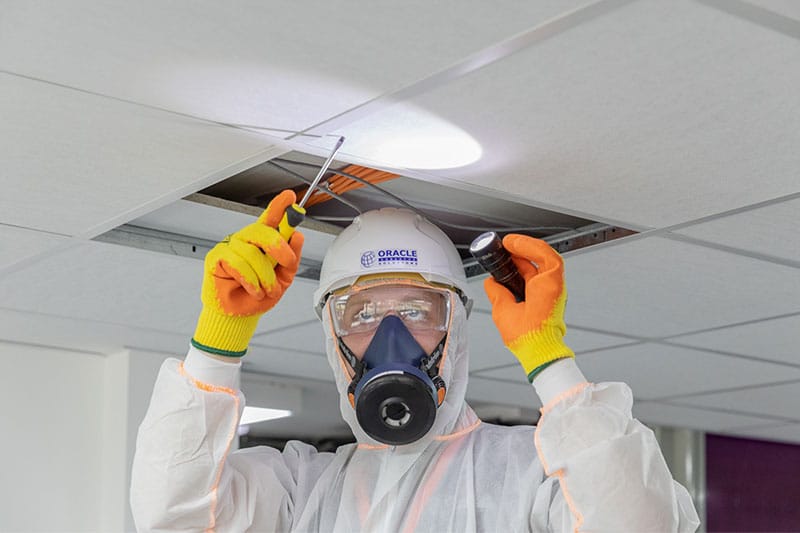What does the job of an asbestos surveyor involve?
Asbestos surveyors are vital to keeping people safe. When asbestos is damaged or disturbed, it can release dangerous fibres into the air. Since these fibres are so tiny, people who are breathing them in may not even know the air is contaminated.
Asbestos surveying involves a variety of responsibilities, from inspecting a building to analysing asbestos samples and creating a thorough report of the findings. Surveyors also need expert-level knowledge of different building types, asbestos types, materials that commonly contain asbestos, and safety measures.
Buildings in the UK that were constructed before 1999 likely contain asbestos. There are so many places asbestos can be, and non-experts may not realise that dangerous asbestos is nearby. By surveying buildings, asbestos is found and analysed so steps can be taken to keep everyone safe.

What does the job of an asbestos surveyor involve?
Asbestos surveyors have a lot of different job responsibilities. For example, a surveyor will do some or all of the following for a project:
- Analyse technical drawings of a building to see where asbestos-containing materials (ACMs) are likely present.
- Follow safety precautions when accessing difficult-to-reach areas of a building.
- Safely dispose of asbestos-contaminated equipment and clothing once a survey is finished.
From inspection through analysis and reporting, here’s an overview of what a typical surveying job involves.
Conducting comprehensive surveys
Asbestos surveyors conduct comprehensive surveys to find out where ACMs are in a building or on a property. This involves thoroughly inspecting the premises and identifying potential ACMs.
Sampling and analysis
Once an ACM is found or the surveyor suspects that asbestos is present, they take representative samples. The asbestos surveyor’s job also involves making sure that the samples are properly handled and analysed by an accredited laboratory.
Risk assessment and management
The asbestos survey evaluates the condition and friability (how easily a material crumbles) of the ACMs. This helps them assess the potential for fibre release and determine the level of risk to building occupants and workers.
Reporting and documentation
Once the survey has been carried out, the asbestos surveyor will prepare a detailed report with the findings. The report will include information about the ACMs, such as location, type, and condition. Additionally, the report will detail the surveyor’s recommendations for asbestos management or removal.
Types of asbestos surveys
According to the Health and Safety Executive (HSE), there are three main reasons why asbestos surveys are carried out:
- To find ACMs and record what the material is, where it’s located, and how much of it is present.
- To record how accessible the ACM is and its condition.
- To determine and record the type of asbestos present, often by sampling.
Note that the HSE defines ACMs as materials that are “either known to contain asbestos or presumed to contain asbestos.”
In this section, we’ll take a look at the different types of asbestos surveys. The HSE says that the building owner, duty holder, employer, and surveyor need to be on the same page about the type of survey that will be conducted, where the survey will be conducted, and what will be recorded.
Management surveys
A management survey is used to manage ACMs when a building has normal occupancy. Here’s what happens during this type of survey:
- Regular inspections to monitor ACMs on the premises.
- Assessments of ACMs to determine their condition and potential for releasing fibres.
- Causing minor disturbances to the ACMs for the sake of assessing the material and determining its fibre-release potential.
The purpose of management surveys is to keep occupants safe in the presence of ACMs while preventing the ACMs from being damaged or disturbed.
Refurbishment and demolition surveys
A refurbishment and demolition survey is used when a building needs to be renovated or demolished. It’s often conducted before major renovation or demolition projects to identify ACMs that could be disturbed by the work. The survey includes:
- Locating and identifying ACMs before work begins.
- Disturbing and sometimes destroying ACMs for inspection purposes.
- Having the area vacated during the survey and certified as safe to return to following the survey.
The purpose of this type of survey is to keep people safe when working on premises that contain ACMs. It also helps in choosing the correct contractor for the job, namely someone with experience working with asbestos.
Reinspection surveys
Reinspection surveys are periodic follow-up surveys to reassess ACMs over time and monitor changes in the condition of the materials as well as the risks to building occupants. They’re performed in buildings that have already had an asbestos management survey. Here’s what takes place during a reinspection survey:
- The asbestos surveyor refers to the existing management survey to examine each of the ACMs listed.
- The conditions of the ACMs will be assessed. If there’s damage, the surveyor will come up with a plan to protect the ACM.
- New photographs of the ACMs will be taken.
- A new asbestos management report will be issued with updated information and suggestions for keeping the premises safe.
Managing asbestos is the duty holder’s legal responsibility, and that requires that ACMs be monitored on a regular basis for any significant changes. At the least, asbestos surveys must be updated once a year. Learn more here.
Essential skills and qualifications
There are a number of skills and qualifications that asbestos surveyors possess. These include:
- Competence in sampling, analysis, and risk assessment methodologies.
- Excellent attention to detail and observational skills.
- Extensive knowledge of asbestos regulations and guidelines.
- Proficiency in survey techniques and equipment.
- Strong communication and report-writing abilities.
Additionally, asbestos surveyors must have one of the following certifications: The Royal Society for Public Health (RSPH) Level 3 Award in Asbestos Surveying or the P402 Surveying and Sampling Strategies for Asbestos in Buildings qualification from the British Occupational Hygiene Society (BOHS).
Importance of collaboration and cooperation
Asbestos surveyors often have to collaborate with other contractors, as well as building owners, managers, and occupants. Knowing how to work well with others is necessary to achieve the following:
- Gaining access to all areas for comprehensive surveys.
- Collecting accurate information and documentation.
- Ensuring timely and effective asbestos management.
- Safely carrying out work in a building without putting others at risk.
Moreover, surveyors often have to communicate technical information about asbestos management with others who don’t have the same level of knowledge on the topic. It’s helpful to know how to convey that type of information in a way that can be understood by the layman.
Final thoughts about the role of an asbestos surveyor
The responsibilities of an asbestos surveyor are key in maintaining a safe environment for building occupants and contractors. Job duties include:
- Knowing the ins and outs of asbestos regulations.
- Utilising observational skills to survey a property and determine where asbestos is present.
- Understanding how to use surveying equipment.
- Taking samples of asbestos for analysis.
- Assessing the risk of ACMs.
- Deciding the best way to manage the ACMs.
- Documenting the findings of the survey.
- Communicating with others so everyone understands how to manage asbestos on the premises.
- Continuing their education and professional development in the field to always know the latest findings and best practices.
Damaged ACMs can release microscopic fibres that get inhaled, stick to the lungs, and stay there permanently. Asbestos exposure can lead to life-threatening diseases in the future, requiring aggressive treatments and often resulting in death. To stay safe, it’s imperative to know what’s in the building around you and how much of a risk it poses.

Written by Callum McDonald
Callum McDonald is an expert in asbestos quality management, ensuring rigorous adherence to regulations and high-quality standards in removal projects. His focus on enhancing quality and client satisfaction makes him a crucial asset in safety and compliance within the field. Callum's expertise in technical support and oversight of licensed works underscores his commitment to excellence in asbestos management, providing invaluable guidance to clients in this specialised area.
